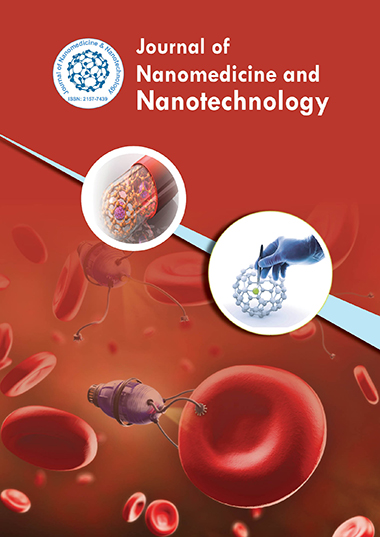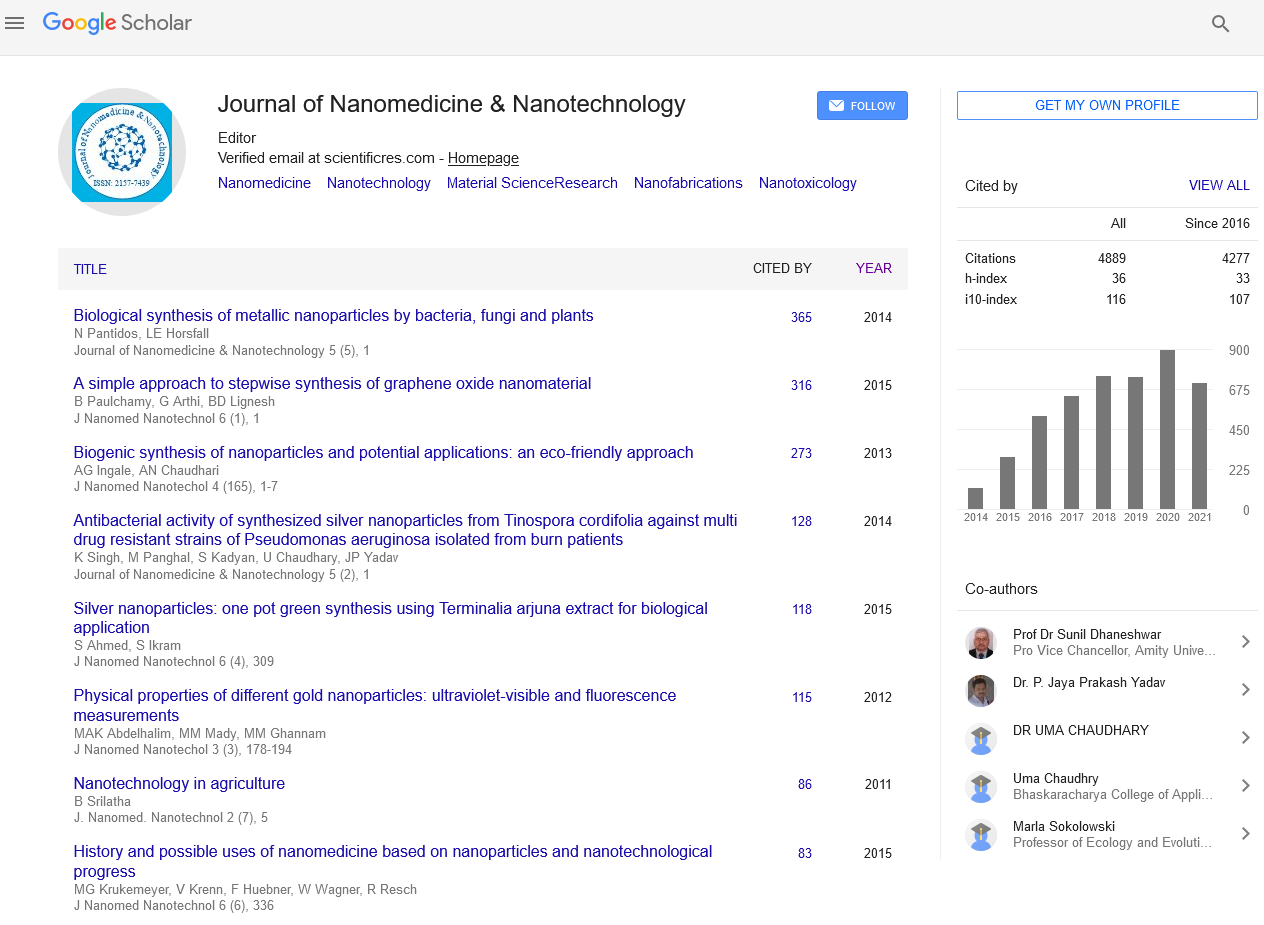Indexed In
- Open J Gate
- Genamics JournalSeek
- Academic Keys
- JournalTOCs
- ResearchBible
- China National Knowledge Infrastructure (CNKI)
- Scimago
- Ulrich's Periodicals Directory
- Electronic Journals Library
- RefSeek
- Hamdard University
- EBSCO A-Z
- OCLC- WorldCat
- SWB online catalog
- Virtual Library of Biology (vifabio)
- Publons
- MIAR
- Scientific Indexing Services (SIS)
- Euro Pub
- Google Scholar
Useful Links
Share This Page
Journal Flyer

Open Access Journals
- Agri and Aquaculture
- Biochemistry
- Bioinformatics & Systems Biology
- Business & Management
- Chemistry
- Clinical Sciences
- Engineering
- Food & Nutrition
- General Science
- Genetics & Molecular Biology
- Immunology & Microbiology
- Medical Sciences
- Neuroscience & Psychology
- Nursing & Health Care
- Pharmaceutical Sciences
Editorial - (2024) Volume 15, Issue 5
Nanotechnology in Gene Therapy: Novel Approaches for Nucleic Acid Delivery
Min-seo Lee*Received: 03-Sep-2024, Manuscript No. jnmnt-24-27137; Editor assigned: 05-Sep-2024, Pre QC No. jnmnt-24-27137 (PQ); Reviewed: 20-Sep-2024, QC No. jnmnt-24-27137; Revised: 24-Sep-2024, Manuscript No. jnmnt-24-27137 (R); Published: 30-Sep-2024, DOI: 10.35248/2157-7439.24.15.751
Abstract
Nanotechnology has emerged as a revolutionary approach in gene therapy, significantly enhancing the delivery of nucleic acids. Traditional methods often face challenges related to stability, specificity, and cellular uptake. Nanocarriers, designed to transport genetic material, can improve bioavailability and targeting, thereby increasing therapeutic efficacy. This article reviews the latest advancements in nanotechnology for nucleic acid delivery, including the types of nanocarriers, their mechanisms of action, and their applications in gene therapy. Future directions and potential challenges in this rapidly evolving field are also discussed.
Keywords
Nanotechnology, Gene Therapy, Nucleic Acid Delivery, Nanocarriers, RNA Interference, CRISPR, Targeted Therapy
INTRODUCTION
Gene therapy has the potential to transform the treatment of genetic disorders, cancers, and various diseases by directly targeting the underlying genetic causes. However, effective delivery of nucleic acids—such as DNA, RNA, and CRISPR components—remains a significant challenge. Conventional delivery methods, including viral vectors, often face issues like immunogenicity, limited packaging capacity, and off-target effects. In contrast, nanotechnology offers innovative solutions to improve the delivery and stability of nucleic acids [1]. This article explores the role of nanotechnology in gene therapy, focusing on novel approaches for nucleic acid delivery.
TYPES OF NANOCARRIERS FOR NUCLEIC ACID DELIVERY
Nanocarriers can be classified into several categories based on their composition and mechanism of action. Key types include:
Lipid-Based Nanoparticles
Lipid-based nanoparticles, such as liposomes and solid lipid nanoparticles (SLNs), are widely used for nucleic acid delivery due to their biocompatibility and ability to encapsulate both hydrophilic and hydrophobic agents. Cationic liposomes facilitate the complexation of negatively charged nucleic acids, enhancing cellular uptake through endocytosis [2]. Recent developments in lipid nanoparticles (LNPs) have shown promise in mRNA delivery, exemplified by the success of mRNA vaccines during the COVID-19 pandemic.
Polymer-Based Nanoparticles
Polymeric nanoparticles offer versatility in design and functionality. Biodegradable polymers, such as poly(lactic-co-glycolic acid) (PLGA) and polyethylene glycol (PEG), can encapsulate nucleic acids and provide controlled release. Polymeric carriers can be engineered to respond to specific stimuli, such as pH or temperature, to release their payloads selectively [3]. For example, chitosan nanoparticles have been used for delivering siRNA in cancer therapy, demonstrating enhanced therapeutic efficacy.
Inorganic Nanoparticles
Inorganic nanoparticles, including gold, silica, and iron oxide nanoparticles, possess unique physical and chemical properties that can be exploited for nucleic acid delivery. Gold nanoparticles (GNPs) can form stable complexes with nucleic acids, protecting them from degradation and enhancing cellular uptake [4]. GNPs also enable simultaneous imaging and therapy due to their optical properties, making them suitable for theranostic applications in gene therapy.
Dendrimers
Dendrimers are branched macromolecules that can be precisely engineered for drug delivery. Their multivalency allows for high loading capacity of nucleic acids, while their surface can be functionalized with targeting ligands or protective moieties. Dendrimers have shown potential in delivering siRNA and DNA for gene therapy applications, enhancing cellular uptake and reducing toxicity [5].
Mechanisms of Action
Endocytosis and Cellular Uptake
The success of nucleic acid delivery relies heavily on efficient cellular uptake. Nanocarriers facilitate the endocytosis of nucleic acids into target cells. Following endocytosis, the nanocarriers must escape the endosome to release their payload into the cytoplasm. Strategies such as pH-sensitive materials or membrane-disruptive agents can enhance endosomal escape, improving delivery efficiency.
Protection from Nucleases
Nucleic acids are susceptible to degradation by nucleases present in biological fluids. Nanocarriers provide a protective environment that shields nucleic acids from enzymatic degradation, thereby improving stability and bioavailability [6]. This protection is crucial for maintaining the therapeutic efficacy of the delivered nucleic acids.
Targeting and Specificity
Functionalization of nanocarriers with ligands that target specific receptors on the surface of cells can enhance the specificity of nucleic acid delivery [7]. Targeting moieties, such as antibodies, peptides, or aptamers, can direct the nanocarriers to diseased cells, minimizing off-target effects and enhancing therapeutic outcomes.
Applications in Gene Therapy
RNA Interference (RNAi)
RNA interference is a powerful mechanism for silencing gene expression, and nanocarriers play a crucial role in delivering small interfering RNA (siRNA) to target cells. Nanoparticle-based delivery systems have shown promise in targeting oncogenes in cancer therapy. For example, polymeric nanoparticles loaded with siRNA targeting the KRAS gene have demonstrated effective tumor regression in preclinical models.
CRISPR/Cas9 Delivery
CRISPR/Cas9 technology enables precise genome editing, offering potential cures for genetic disorders. However, efficient delivery of CRISPR components is a major hurdle. Nanocarriers, such as lipid nanoparticles, have been developed to deliver CRISPR/Cas9 complexes to target cells, facilitating gene editing with high efficiency and reduced off-target effects [8]. Recent studies have highlighted the potential of using LNPs for in vivo delivery of CRISPR/Cas9 for therapeutic applications.
Gene Vaccines
Gene vaccines, which deliver nucleic acids encoding antigens to stimulate an immune response, are an area of active research. Nanocarriers can enhance the stability and uptake of these vaccines, improving their efficacy. For instance, mRNA vaccines for infectious diseases, such as COVID-19, utilize lipid nanoparticles for effective delivery, leading to robust immune responses [9].
Treatment of Genetic Disorders
Nanotechnology holds promise for treating genetic disorders by delivering therapeutic nucleic acids to correct genetic defects. For example, nanoparticles have been explored for delivering therapeutic genes or antisense oligonucleotides to treat conditions such as muscular dystrophy and cystic fibrosis. The ability to achieve targeted delivery enhances the potential for successful treatment outcomes.
FUTURE DIRECTIONS AND CHALLENGES
Enhanced Targeting Strategies
Future research should focus on developing more sophisticated targeting strategies to enhance the specificity of nucleic acid delivery. Combining passive and active targeting approaches, such as using tissue-specific ligands alongside EPR effects, could significantly improve therapeutic efficacy.
Long-Term Stability and Biocompatibility
Ensuring the long-term stability and biocompatibility of nanocarriers is essential for their successful clinical application. Future studies should evaluate the long-term biodistribution and potential toxicity of nanocarriers to establish safety profiles for human use [10].
Regulatory Considerations
As nanotechnology advances in gene therapy, regulatory frameworks must evolve to address the unique challenges posed by nanocarriers. Developing clear guidelines for the evaluation of safety, efficacy, and manufacturing quality will be critical for the successful translation of nanotechnology-based therapies into clinical practice.
Integration with Personalized Medicine
The future of gene therapy may lie in integrating nanotechnology with personalized medicine approaches. By tailoring nanocarriers to individual genetic profiles and disease characteristics, researchers can develop more effective and safer therapies for diverse patient populations.
CONCLUSION
Nanotechnology has transformed the landscape of gene therapy, offering novel approaches for the delivery of nucleic acids. The development of various nanocarriers has enhanced the stability, specificity, and efficacy of nucleic acid delivery systems. As research continues to advance, the potential for these technologies to revolutionize the treatment of genetic disorders, cancers, and infectious diseases becomes increasingly apparent. By addressing current challenges and exploring innovative solutions, nanotechnology holds the promise of unlocking new possibilities in gene therapy.
REFERENCES
- Smith A M, Lee K. Conjugated Polymer Nanoparticles for Imaging and Therapeutics. Bioconjugate Chemistry. 2022; 33(1): 1-13.
- Brown M, Anderson R, Artis D. Intestinal Memory CD4+ T Cells Function to Suppress Inflammation in the Gut. Journal of Immunology. 2018; 187: 16-187.
- Anderson J C, White K A. Structure of the African swine fever virus major capsid protein p72. Cell Reports. 2021; 36(7): 109454.
- Schleich N, Sibret P, Danhier P, Ucakar B, Laurent S, Muller R N, et al. Dual anticancer drug/superparamagnetic iron oxide-loaded PLGA-based nanoparticles for cancer therapy and magnetic resonance imaging. Int J Pharm. 2014; 466(1-2): 172-185.
- Miller K D, Nogueira L, Mariotto A B, Rowland J H, Yabroff K R, Alfano, et al. Cancer treatment and survivorship statistics, 2019. CA Cancer J Clin. 2020; 69(5): 363-385.
- Lee S, Patel T. Tumor-Targeted Drug Delivery Utilizing Engineered T Cells. Frontiers in Immunology. 2018; 9: 2294.
- Garcia J R, Davis J. Probing Targeted Nanoparticle Surface Interactions with Cellular Membranes. ACS Nano. 2019; 13(8): 9137-9151.
- Parker N, Smith A. Multiple Myeloma Antibodies and Targeted Therapies. Hematol Oncol Clin North Am. 2019; 33(1): 37-55.
- Johnson D E, O'Keefe R A, Grandis J R. Targeting the IL-6/JAK/STAT3 signalling axis in cancer. Nat Rev Clin Oncol. 2022;19(3): 208-222.
- Smith A M, Davis J. Increasing the accuracy of nanoparticle sensing using a multi-level gating approach. Nature Communications. 2019; 10(1): 1-9.
Indexed at, Google Scholar, Crossref
Indexed at, Google Scholar, Crossref
Indexed at, Google Scholar, Crossref
Indexed at, Google Scholar, Crossref
Indexed at, Google Scholar, Crossref
Citation: Min-seo L (2024) Nanotechnology in Gene Therapy Novel Approaches for Nucleic Acid Delivery. J Nanomed Nanotech. 15: 751.
Copyright: ©2024 Min-seo L. This is an open-access article distributed under the terms of the Creative Commons Attribution License, which permits unrestricted use, distribution, and reproduction in any medium, provided the original author and source are credited.
Competing interests: The authors have declared that no competing interests exist.


